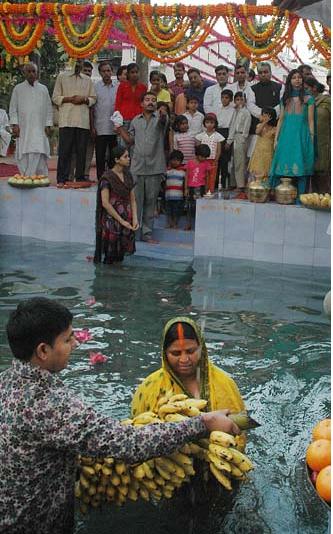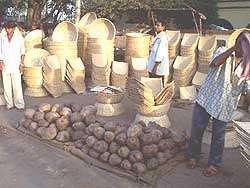Hullo, everyone,
Yes, I know, Bihar is crazy. But if you have to see it absolutely, irreconcilably, irretrievably, irrevocably mad, this is the season for it -- Chhath.
 Whether rich or poor, young or doddering, a queen like Rabri Devi or a shanty-dweller, Hindu or Muslim, everyone goes crazy. Every alley is swept, every road decorated, special rules are followed by the Patna Municipal Corporation to see that every nook, cranny and corner are clean and lighted etc, etc, etc ... Whether rich or poor, young or doddering, a queen like Rabri Devi or a shanty-dweller, Hindu or Muslim, everyone goes crazy. Every alley is swept, every road decorated, special rules are followed by the Patna Municipal Corporation to see that every nook, cranny and corner are clean and lighted etc, etc, etc ...
Trucks are hired, cars borrowed, space on the banks of the Ganga looted, masculine help from wherever it can be found garnered, thieves postpone all activity, rapists defer theirs, recalcitrant sons turn overnight into obedient ones and husbands who haven't looked at their wives in ages take their turn to press her feet ...
And those Bihari women, who live in far-off lands also manage with their husbands and sons pouring water by the bucketful pretending they are standing in the Ganga.
But ask any of these why she indulges in all the rather rigorous religious rigmarole spread over three days, marked by offerings made to the dying sun then the setting sun and she'll never be able to tell you why.
 And another question that comes along is -- why is there no temple to the sun in a land where people go mad for the sake of the sun? In fact, there are only a dozen sun temples in India and the best recognised happens to be in our neighbouring state of Orissa. And another question that comes along is -- why is there no temple to the sun in a land where people go mad for the sake of the sun? In fact, there are only a dozen sun temples in India and the best recognised happens to be in our neighbouring state of Orissa.
No one knows.
Here there are two stories involved. Once upon a time in the Dwapar-yug, there reigned a King Shyam, who was good, just and highly popular. But he happened to get the dreaded leprosy. Many of his faithful courtiers around him also contacted the disease.
Maintaining that only a king who was mentally and physically fit should rule over his people to be able to give them his best, he abdicated in favour of his younger brother.
Someone suggested that when poet Mayurbhatta had had the disease, he had made a pilgrimage of all the temples devoted to the sun and then written an immortal set of hundred couplets praising the sun, the Surya-shatakam.
King Shyam, too, set off on a pilgrimage to the twelve sun temples of the country. Many of those who loved him, also insisted on going along in order to look after him.
The little band of people went around India, painstakingly offering prayers at every sun temple. But the condition of King Shyam became worse by the day. The last temple was Konark and made for it. On their way they were crossing the deep forests at the foot of the seven-hilled Magadhan capital, Raj-griha.
Tired and thirsty, they decided to rest under some trees. And the prime minister told some of his men to look around for some river, some source of water ...
They went looking, but found nothing. When they saw the sun lowering above the forest they started back. Just then one of them saw a dirty pool of water -- several pigs lay about in it. They stopped and pondered -- to let their king die of thirst was a sin they would never be able to overcome in many lives, but to give him this dirty water ... ?
One of them decided to let the king make the decision -- taking some clean cloth he scooped up some water into his lota, straining it ...
Suddenly, he noted that the ugly patches of leprosy on his hand had magically vanished. He told the others. They, too, washed themselves in the water and were healed.
They went running in glee to their king.
This Surya-kund is said to heal all kinds of skin diseases even today -- it lies hardly five minutes walk from where the remains of the world's oldest university is -- Nalanda University -- which you leave to the left.
The other story is about the king of Magadha, Bimbisara or Ajatashastru (I think it was the latter -- Bimbisara was the one Ajatshatru jailed to become king himself) who was an unhappy man because he did not have a son to pass his sceptre on to and it was unthinkable that the great kingdom of Magadha should go without an heir. He had married twice, but to no avail ...
The courtiers and subjects, all shared their king's unhappiness. The whole land was plunged into gloom.
One day a man came running in with news for the king -- there was a sage in the forests who could grant any man his wish. Happily, the court prepared to make offerings to the famous sage and they all went along.
The sage gave the king a fruit and said to give it to his queen.
But on their return, the king could not decide what to do -- it was not the senior queen's fault, and certainly the younger queen was as innocent. What should he do?
Finally, he cut up the fruit into two equal halves ...
When the time came -- the sixth day or chhathi of the shukla paksha after Diwali, both the queens delivered perfectly-formed, beautiful babies -- but in halves. And unmoving and lifeless.
The king was shocked. Quickly deciding that the queens must not see their babies, he ordered that they both be thrown away in the forests.
But in the same forest lived a formidable demoness whom everyone feared -- Jara, and she too wished for a baby -- any kind, from anywhere and she swore she would make it hers.
That day, as evening came on and the setting sun made for the horizon, Jara sat up, her energies renewed at the onset of the bewitching, dark hours and, eager to start her search, she set off ...
And there was this baby, lying lifeless.
Delighted she caught a glimpse of the setting sun through the green foliage and said a moment's prayer, 'Suryadev, you put life in all living things, please bless this baby, too ...'
And she bent and gathered up the two halves into her loving arms. And the baby cried out ...
The king's men hadn't got very far -- and they returned to claim the baby.
Quarrelling, they all went into the presence of the king. And the king made a just decision, 'You, Jara, will for ever be known as the Mother. But the future king of Magadh cannot be brought in the forest.
He has all languages to learn and yuddhavidya, arthashastra, dhanurvidya, etc, to learn.'
The demoness agreed to this.
'So, you will come and go here as and when you please but the prince will be brought up as befits the future ruler of the mighty Magadhan empire.'
That is why the whole of Bihar makes offerings to the setting sun.
Then offerings or arghya are offered to the rising sun.
This is Chhath, and Jara is the Chhathi Maiya to whose life-giving glory thousands of songs are sung.
And so great is Chhathi Maiya, so vast the reach of her blessings that even to pick up a pebble from the path of a woman undertaking chhath as she makes her way to the Ganga incurs the blessings of Chhathi Maiya.
This is also the Jarasandh (by the way its jara plus sandhi) of the Mahabharata fame whom Bheema, the Pandava wrestled with. Jarasandha's akhara is still there in Rajgir for all to see -- since it was irrigated with milk, the soil is white and sparkling in the akhara while round it is deeper-coloured, granite-coloured soil.
OK, then, see you next time. Shruti |
